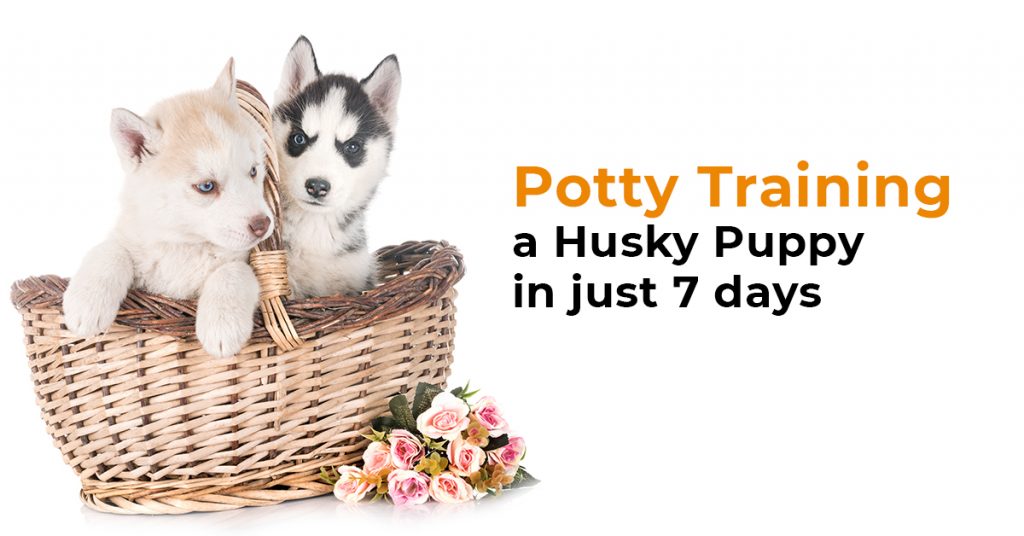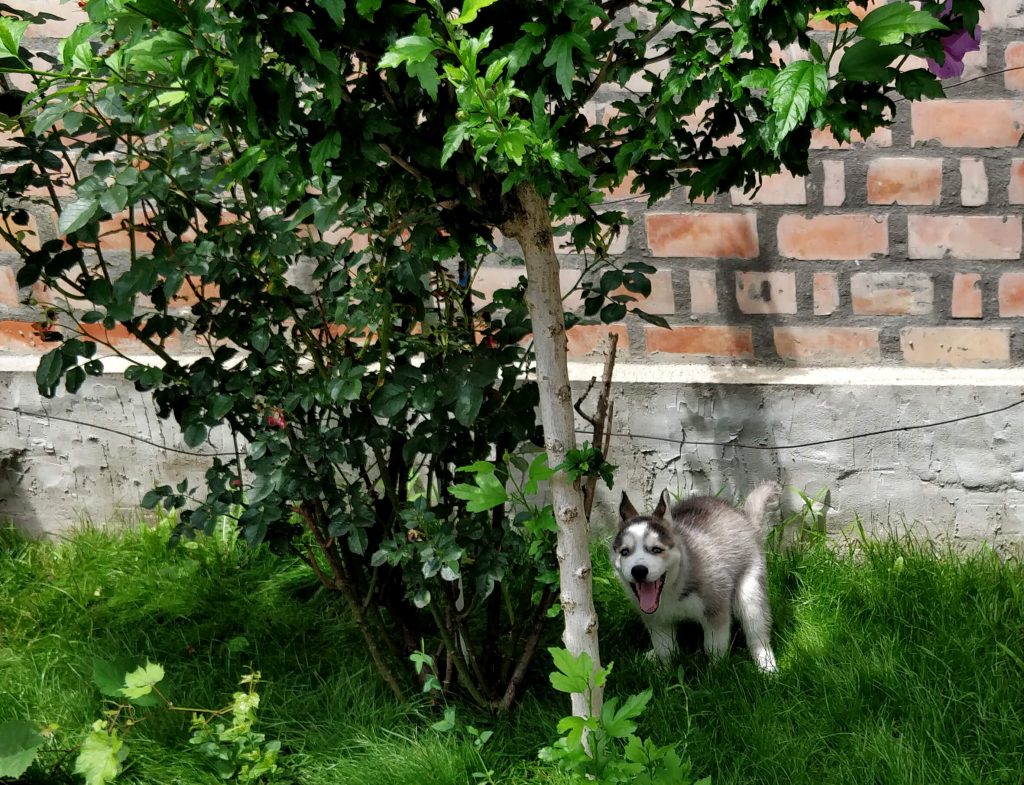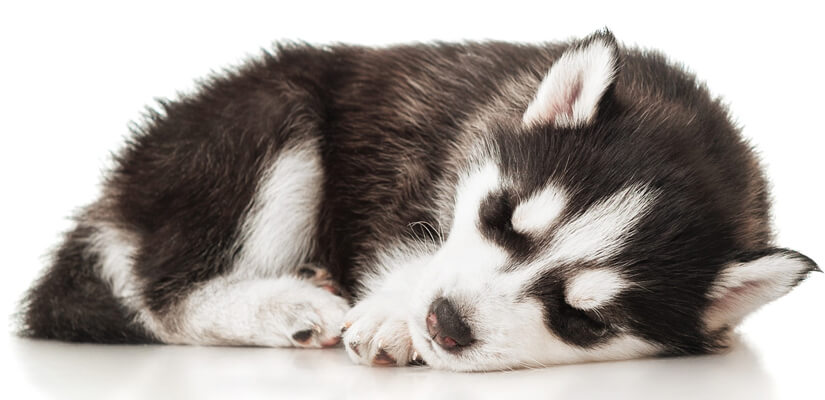The most often asked question by new Husky puppy owners is: How do I potty train my Husky? He just pees everywhere!
So you just got your Husky puppy. Fear not! Potty training can sometimes be a frustrating process or a pesky problem to deal with. All you need is a plan, and some good tips & advice on what to do and when. So let’s talk about potty training!
What you’ll need to successfully potty train your Husky
Setting up for success means proper planning. So here’s what you’ll need for as little fuss as possible when accidents happen, or you’re training your puppy.
- Patience. This is not done overnight, and it might be frustrating to see no or little progress each time.
- A positive attitude and an observing eye. You probably just got your Husky puppy. The most important thing you can do right now is to keep an eye on him, so he does not pick up bad habits.
- Time. This is going to take some time, and probably for the first month or two, you will need to dedicate some time for certain actions (read below)
- A designated potty area. Your pick, be wise – he’s going to get bigger and bigger, and you don’t want big logs on your front yard.
- Some paper towels for removing the mess.
- A specialized pet mess cleaner or just some good universal floor cleaner. Just make sure it does not contain ammonia.
- An easy-to-fill spray bottle (in an empty window washing container or something) with 3 parts vinegar and 1 part cleaning solution. You’ll use this to discourage him from making his needs in that spot.
- Of course, some delicious high-value treats! Pick something low in calories, healthy, or why not, some fruits! Bits of cheese will also do the trick.
The Husky puppy bladder and a potty schedule
Most of the times you can expect your Siberian Husky puppy to be able to hold his bladders in as many hours as his age plus one.
This means that if your puppy is 3 months old, he’ll probably be able to hold it about 4 hours tops.
So when do puppies usually need to poop or pee?
Of course, it’s not an exact science, but usually, you can follow the below patterns. Be on the lookout for these activities and times, and you’ll surely figure out when your pup needs to do his business.
- Within 15 to 20 minutes after eating or drinking, they usually need to pee or poop;
- After a lot of play and or excitement, they need to poop/pee;
- When they wake up after a nap, they will most surely need to go;
So what now?
When these events occur, it’s a good time to take him out. Just finished eating? Let’s go out and walk, play or discover the yard. Be near the designated potty area. And so on.
And repeat. I told you it would eat some of your time.
Creating a schedule for him to go outside and near or at the potty place in his early days will set a pattern in his mind. We want this.
So he went potty outside or at the potty place. What to do?
Praise him right after he’s finished doing the work. You can also sometimes give him a treat when this occurs.
The best way to teach a Husky something is through positive reinforcement. He’ll quickly learn that he’s a good boy. After a while, you can start holding back on the treats and just praise him – but only after some consecutive days of going outside like a good boy.
An accident just happened inside the house What now?
DO NOT yell at your puppy or show signs of frustration or excitement. Your Husky is learning something new, and negative emotions will hinder the process.
Also, you don’t want him to do it just to get your attention in the future, do you?
After he’s done, take him to the designated spot. Maybe the scent of his past waste will make him go again. Calmly show and tell him what you want him to do over there.
When returning at the ‘crime scene’, follow these steps:
- Remove as much of the mess as possible using paper towels and dispose of them.
- Abundantly spray or put some specialized pet mess cleaner or a cleaning solution on the place, let it soak for a couple of seconds to 1 minute.
- Wipe the excess solution and let the floor air dry.
- Spray the 3 part vinegar and one-part cleaning solution on the spot. Vinegar will keep him from wanting to eliminate on that spot again.
Yes, your house might smell like a salad with vinegar for a couple of days. It’s worth it! Once your pup is trained, you’ll have a great time together!
Keep in mind that he’s young. Accidents will happen, especially during the first few weeks. Apart from being a new thing he has to learn, he’s probably accommodating with your home.
How to handle your Husky overnight when potty training?
This is the hardest part. Or it always was for me.
You must be prepared to take him out at least once at night. He will need to pee or poop if he’s just 3 to 5 months old. What I like to do is this:
- After his last meal of the day, make sure he poops and pees outside.
- Stay up later than usual. I usually stay up until midnight, or even 1 am when needed. He’s probably napping, so you want to catch him between night naps. As soon as he wakes up or he has had a 3 to 4 hours nap, take him to the potty place. Then you can go to sleep.
- A great plan if you can do it is to wake up ar about 5 or 6 am. He will most likely wake up, and you know what you have to do.
- His crate or designated sleeping place is near the bed in the first weeks, so you can hopefully hear him if he wakes up. A semi-opened door that squeals or trips something does wonder! Huskies usually do not pee where they sleep – they got this from their mother. So if you can make sure he makes some noises you can get up and direct him towards the right place to go potty.
This way, you will actually need to wake up just once a night. It’s hard, but thankfully it does not last forever.
Oh, and another tip: try not to excite him too much in the night. The cool air will wake him up in a second and you might find yourself in the middle of a 1 am playing session when you just want to go to bed.
Final thoughts – follow this
If you follow all the above tips and tricks for at least 7 days, you’ll find yourself with a puppy that happily goes out to potty. And your home can then stop smelling like a salad.
But keep at it! Persistence is key! Just because he went potty in the right place for a couple of days does not mean the praise needs to stop and you’re done. You want to make sure to support his great new habit for the following months. Of course, not as much as in the first week or weeks, but it’s still needed.
A small note would be that it is vital that you, as an owner, to do the initial training. The leader of the pack must teach the fresh recruits. Don’t delegate this important part of training your dog to someone else! A great leader is fair and responsible. So be a great pack leader!
So as long as potty training your Husky puppy goes, do it as early as possible, for a great start to an obedient friend and clean floors.
I hope you found the above ideas helpful in potty training your Siberian Husky and feel free to tell me about your experiences below in the comment section!
If you enjoyed this article I think you’ll find my guide on grooming and bathing a Husky at home very useful!




11 Comments
We have recently brought home a 6 month old puppy, where the previous owners idea of potty trained was leaving her outside to do her business. She seems to be having trouble holding her pee in for long periods of time, we were taking her every hour and she went every time we took her. We were able to push it up to 2 hours recently, but as soon as we try for every 3 hours, she has an accident inside the home, or inside her crate. Given that, she cannot hold her pee in over night. We have made her crate the appropriate size, but she ended up peeing inside anyways and started to cry in the middle of the night because of it.
Unfortunately, you will need to teach her where to go potty and get her on a new schedule. She is still a puppy, and she had no potty training (that wasn’t potty training). What’s her schedule? Try to feed her three times per day and take her outside after. She will also drink water before or after these 3 meals. Don’t feed her after 7 pm if you don’t want any accidents during the night. You can put ice cubes instead of water in her water bowl during the night. This way, she will not drink too much at once, but she will be hydrated. Don’t forget to establish a verbal command and to praise her when she pees – she is a smart girl, I’m sure she will get it fast. If she finds a favorite spot where to pee outside, she will usually pee there. Don’t forget to praise her like it’s the biggest accomplishment of her life. If your husky is not used to stay in crate, try to start with only two hours per day. Is she comfortable in the crate all night?
hi i currently have a 3 month old puppy and we are taking her out every hour but we still end up with accidents in the house especially if we had to leave for a hour or 2 even though we take her out right before and right after we leave she still ends up peeing in the house we have tried praising her and giving her treats when she goes outside but shes not food motivated
Hi! At 3 months old she doesn’t have too much control because her bladder is small. It’s pretty tricky when she’s small. You can put some dog pee pads in a place where she can pee when you’re not home. Due to spam I just saw your message, sorry for the delay. Your girl should be almost six months old and she should have control over her bladder. If she is still peeing inside, you can take away her water bowl during the night or put just some ice cubes in the bowl (no water, just ice).
She may have understood your commands but she was too small for that.
Make sure your husky isn’t peeing inside when you are gone due to anxiety. I’m just guessing here because I don’t know the current situation.
Again, sorry for the delay. Don’t hesitate to contact me if you have other questions.
HI. i have the same case, mine is like 3 months old as well. he still peepee inside the house. and I have to be at work for atleast 6-8hrs every 2 days. i am leaving him a half full bowl of water and right after he drinks i can see that he pees after 5minutes. is it ok to do potty training in a crate if this is my case?kindly give some advise regarding this matter. thank you!
Hi! It sounds like you’re managing a common challenge with your young pup. Potty training while balancing work commitments can be tricky, but it’s definitely doable. Crate training can be an effective method, especially since it taps into a dog’s natural instinct to not soil their sleeping area. Here are a few tips to help you along:
Crate Training: Using a crate can help manage and reduce accidents, especially when you can’t supervise directly. Make sure the crate is only large enough for your puppy to stand, turn around, and lie down. Too much space, and they might decide one corner is fine for peeing. Introduce the crate gradually, making it a positive space with comfy bedding, toys, and occasional treats.
Water Intake: Managing water intake is important, but puppies do need adequate hydration. Instead of leaving a half-full bowl of water, you might try giving your puppy access to water at specific times, such as meal times and after play sessions. This can help establish a more predictable potty schedule.
Potty Breaks: Since your puppy tends to pee about 5 minutes after drinking, you can use this predictability to your advantage. Try to schedule a potty break right after your puppy drinks water, and praise them lavishly when they do their business outside. Consistency is key—taking them out at the same times each day helps establish a routine.
During Work Hours: When you’re at work, depending on the puppy’s age and bladder control, he might need a break every few hours. If possible, have a neighbor, friend, or professional pet sitter come to let him out for a potty break and a little playtime while you’re away. This can prevent accidents and help continue the potty training process.
Positive Reinforcement: Always use positive reinforcement. Reward your puppy with treats, praise, or playtime when they pee outside. This makes them more likely to repeat the behavior.
Patience and Consistency: Like any form of training, consistency is vital. Puppies learn through repetition, so maintaining a consistent schedule and using positive reinforcement will help your puppy learn where and when it’s appropriate to go.
Thank you for reaching out and best of luck with your potty training journey! Your dedication will surely pay off as your puppy grows and learns.
Hi! I have a 6-month-old Siberian husky. For the last month she has been doing really well regarding potting inside. We hadn’t had a mess inside in a long time. However, the last week we’ve been having multiple accidents a day. We take her out consistently and we have a bell for her to ring when she needs to go out and she does ring it when she needs to go to the bathroom. However, this last week she’s just been going all over the house.
It’s completely normal for a 6-month-old Siberian husky to experience a bit of potty training regression, even after weeks of doing well. Around this age, puppies go through developmental changes that can temporarily affect their behavior. Hormonal shifts during adolescence and testing boundaries are common. If she recently gained more freedom around the house, she might not yet understand that every area is off-limits for pottying. Even changes in your routine, weather, or household dynamics can throw her off. Going back to basics-taking her out frequently, supervising her indoors, and rewarding her for going outside-can help reinforce what she’s already learned.
However, since the accidents have been frequent over the past week despite a consistent routine and her using the bell, it’s also worth considering a possible medical issue like a urinary tract infection (UTI). If she’s peeing more often than usual, right after coming back in, or if the urine smells strong or looks off, a quick vet visit can rule that out. In the meantime, keep a close eye on her, clean all accidents with an enzymatic cleaner to remove scent markers, and limit her unsupervised access to the house. Most dogs bounce back quickly from regressions with a bit of patience and consistency!
I want to say thank you for the help! We had started allowing her to sleep in a bed and have free run of the house. We started sleeping her in her crate again after reading what you said about gaining more freedom and not allowing her throughout the whole house unless someone’s watching her. She’s been doing so good! Thank you for the help!
That makes me so happy to hear! 😊 Crate training is such a helpful tool, not just for safety, but also for giving them a calm space of their own. I’m so glad she’s doing well. Don’t hesitate to reach out if you ever need more tips or just want to share updates. Always love hearing how these beautiful floofs are doing! 🐾💙
Having read this I believed it was extremely enlightening.
I appreciate you finding the time and effort
to put this information together. I once again find myself spending way too
much time both reading and posting comments. But so what, it was still worthwhile!